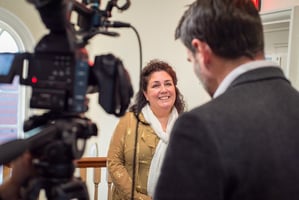Wouldn’t it be good to know what journalists look for in press releases and story pitches?
Pitching isn’t easy, is it?
It can be hard to know which journalists to target.
And it can be even trickier to grab their attention.
The good news is journalists want to receive pitches.
According to Muck Rack’s State of Journalism 2023 study, 55 per cent of journalists say that a quarter of their stories come from pitches.
So, a good pitch has plenty of coverage potential.
But how do you create a story pitch journalists want to read and cover rather than one they quickly spike?
This was the topic of our latest Media Team Academy masterclass.
Victoria Smith, one of our expert media training tutors, was joined by experienced journalist Brendan McGowan, who has more than 20 years of experience at the likes of ITV London and ITN.
And they steered comms professionals through everything they need to know about pitching.
Here’s a recap of the discussion.
How long should a typical pitch be?
Size matters, so let’s start with the question of length.
If you are emailing a pitch – and most journalists say this is how they want to receive them – how long should it be?
Well, brevity is crucial.
“Keep it brief,” Brendan said.
“Planners – the people who look at what future stories we will cover - are looking at hundreds of emails every day, as well as other sources.
“You have to be able to catch their eye quickly. Keep it to one page with a decent headline.
“That headline doesn’t need to be fancy. It just needs to say, ‘This is what the story is, and this is why we think it is important to you’.
“If you can, include a picture. Give us an idea of what we will see if we come and film at your organisation.”
Brendan used the Tottenham Court Road interactive screen to highlight how a simple pitch caught his attention.
He said: “We were looking that day for something for part two of the programme. Something a little bit softer.
“The email was only a couple of lines with a press release. But it said it was a “Big London story” and that we would be “the first to cover it.”
“When someone says that, you don’t want to miss out to a different organisation, and you know it will help you sell it to your editor. So, I wanted to check what he had got.
“The other thing they did was attach a great picture, which showed us what we would be able to see if we went down.
“When I phoned the person who sent it, he explained it was part of the wider Crossrail development, which gave us a news angle as well.
“And we’ve used them again because we know we will get a warm welcome, the visuals are good, and they will make time to put spokespeople up.”
ITV also recently covered a story that started with video footage of a staircase.
“There was a local newspaper story that had embedded some footage from an estate agent about a disused stairwell being sold for £20,000,” he said.
“The video helped us understand the story, what we would see if we went down there, and the journalist could start to structure the piece.
“It also drew us in because it looked grim.
“The other great point about this story is that when the reporter got down there, the estate agent was happy to be interviewed, as were the people living there. But we didn’t have a wider property expert to make a point about the market in London and why spaces like this were being offered for that kind of price.
“So, it highlighted that we don’t have a great property contact, for example, who at the drop of the hat would be willing to go to a location and do an interview.”
What about press releases?
Most pitches will be based on a press release.
Should all the text be included in the body of the email?
The main rule here is to avoid including the press release as an attachment because it could crash inboxes, making you pretty unpopular.
So, either include it as a link in the pitch email or in the text below the pitch.
But whatever format you opt for, get to the point.
“We don’t spend lots of time perusing press releases,” Brendan said.
“We are scanning and moving on to the next one if it doesn’t grab us.
“I think a press release should almost be like a wedding invitation - this is what we are doing, this is where we are doing it, and here is a picture of the bride and groom.
“Keep it simple, concentrating on the 5Ws (who, what, why, where and when). That’s how journalists think, and how press releases should look.”
And that feels like the right point to bring in TRUTH.
Journalists want the TRUTH
It is an acronym we use during our media training courses to help delegates understand what makes something newsworthy, building on those 5Ws.
It stands for Topical, Relevant, Unusual, Trouble and Human interest.
Topical – “We want the stories to be timely or trending,” Victoria said.
Relevant – “The story needs to be relevant to the audience,” she added. “And relatable in terms of the language, images and spokespeople you use.”
Unusual – Victoria said: “We love the ‘unusual’ element. It is something you can have a lot of fun with. It could be an unusual story, anecdote or figures. It could be the first, the biggest, the last, the cheapest, the most expensive or the longest. And there are those analogies, like ‘the size of Wembley Stadium’ and ‘the height of the Empire State Building’. If you can bring the unusual, our ears will prick up.”
Trouble – “We love a bit of trouble or tension to get the audience hooked,” Victoria said. “Some adversity that has been overcome works well.”
Human interest – “This is key and should probably come at the start, but the acronym would not make sense,” Victoria said. “Stories are about people. Give us a case study. Maybe your spokesperson has a personal story they can share that the audience will relate to.”
Brendan believes the template offers story pitches a solid foundation.
He said: “I think if you only have three of these elements, you still have a fighting chance – I would say unusual, human interest and relevant.”
To help bring this to life, Brendan discussed a story he covered about Pimlico Plumbers and the UK’s oldest worker, who was 97 at the time.
“This goes back a while, but I think it illustrates all the parts of TRUTH - it was a clever bit of PR from Charlie Mullins at Pimlico Plumbers.
“They said they had the country’s oldest worker – Buster Martin.
“You don’t hear stories of someone that age still working. We went down and interviewed him – as did everyone else – and he was a great character.
“He was authentic. At the time, there was a lot of talk about apprenticeships. He had been through all of that and was still working.
“The other clever thing was that this was not Buster’s last appearance. They kept the ball rolling as he became the oldest man to run the London Marathon.
“And we lapped it up.”
How do you find the best contacts to pitch to?
So, you feel you have a newsworthy story to share. It passes the TRUTH test.
Who should you pitch it to?
Firstly, you need to consider your target audience. Is this a story that will appeal to a general audience? Is it something more technical that will have greater appeal for a trade publication?
Once you are clear on that, you can build a mailing list of appropriate journalists.
But despite the email preference, sometimes it is worth picking up the phone.
“Don’t be afraid to pick up the phone and speak to the newsdesk,” Brendan said.
“We will sometimes be impatient and busy.
“But we are in the market for your stories – we have to fill a programme.
“There are few people on planning desks. They don’t change often and tend to stay within the organisation for a long time.
“So, get names and email addresses.”
What about social media? Is it worth contacting journalists through Twitter (or X as it is now officially known)?
Brendan said: “Once you know the names of the planning editors, you’ll be able to find them on Twitter and see them making appeals.”
But he also says there are social media places journalists use to source stories and interviewees.
He said: “When looking for case studies and stories, there’s one place we always go to on Facebook called Lightbulb Entrepreneur & Press Hangout.
“If you go on there, you will see desperate planning editors from Sky, BBC, ITV London and newspapers looking for people to speak to about upcoming stories.
“There is a constant flow of requests on there.
“The hashtag #journorequest is worth keeping an eye on Twitter.
“Social media is a good way to get yourself noticed.
“We pick up on things that go viral, and that in itself becomes part of the story.
“The key thing is to know what we want.”
Would it be better to approach an individual reporter rather than a newsdesk?
“If you have a relationship with a reporter, then do that,” Brendan said.
“The journalist will have the heft, if they believe in the story, to get it through the process.
“Even better, the people with the real power are the presenters.
“If a presenter says, ‘I think this is a story worth telling’, that’s quite difficult to bounce back.”
Is there an ideal time to pitch?
There’s plenty of advice on this topic.
And you need to try to hit the send button at the right time.
It is also worth remembering that something only stays newsworthy for a limited time.
The vital thing with timing is to send your story well in advance of when you want it to run.
Brendan said: “If you get in touch two weeks before, we will put it to one side and forget about it.
“I would say the optimum time is around five days, with a follow-up reminder email closer to the time.
“My advice would be to let the news planners get through the first few days of the week – they are quite gruelling, and they are under a lot of pressure.
“Thursdays and Fridays are good days to get their attention. And afternoons work best.”
Does it matter if a story is exclusive?
“Exclusive is a big word,” Brendan said.
“If someone offers you something exclusive, it catches the eye.
“But how exclusive something can be in this day and age is something I would question.
“So, I wouldn’t say exclusivity is a bonus. But it is something you pay attention to.”
What do journalists hate about pitches?
A golden question.
Jargon, vagueness, and a lack of news appeal often top the list.
“Don’t be too salesy,” Brendan said.
“Telling us ‘This is the best thing that has ever happened to the automotive industry, and you will be a fool to miss out’ is a turn-off.
“We’ll decide – it is not for you to tell us how great it is.”
A lack of timeliness is also infuriating.
“It’s frustrating when you get an email about something that happened three days ago,” he said.
“It is a waste of everyone’s time.
“We look forward. It needs to be something happening in the future so we can think about how we will film it and the elements we will need to add to it.”
But some things definitely grab his attention.
He said: “A good thing to say to someone like me is ‘before we go to the BBC’ or ‘before we go to The Times, we just want to give you a chance to think about this story’.
“That immediately makes you think ‘Oh, I better look at this – I don’t want to see this in the opposition tomorrow.”
What about newsjacking?
Newsjacking is a term we increasingly hear more often.
It basically means jumping on something that is already being covered or is trending.
If you can offer a different opinion or element to the story, it can present a brilliant opportunity to grab attention and gain coverage for your organisation.
“Everyone follows the news, and there are things you can anticipate,” Brendan said.
“With the upcoming budget, we will look for case studies and sit down with businesses to see if what is announced is what they were looking for.
“As we get close to a general election, we will think about how we can tell the story over the campaign period. It is likely newsrooms will look to form little business clubs they will turn to again and again.
“If you think in those terms, you can say, ‘We are a button factory in Catford, this is what we are hoping for from the budget or election. We’ve got some great characters. We’d be delighted if you could come down’.”
Brendan also thinks considering diversity can boost newsjacking efforts.
He said: “ITV has a commitment to diversity, but we are often offered male spokespeople.
“We want to feature women, get the gender balance right, and speak to people from ethnic minorities.
“We want our programmes to look like the people watching them.”
Some other potential newsjacking opportunities include the London Mayoral election and its ULEZ battleground, the Euro championships and the Olympics.
“Sports events provide us with phenomenal human interest stories,” he said. “Communities getting behind their athletes, former athletes backing their local hero, and schools cheering for their favourite England stars.”
Should people use influencers to grab a journalist’s interest?
Journalists and influencers can both play roles in helping your organisation reach wider audiences.
But journalists are not keen on hearing about influencers in your news pitches.
“I think there is a natural hesitancy for journalists when it comes to that kind of thing,” Brendan said.
“Why should we believe what they are saying just because they have been on Love Island?
“But celebrities are different.
“I think immediately of Barbara Windsor, who did a lot of work with charities. Every time her agent said she would like to come on and talk about something, she would walk through the door and be treated royally.
“Celebrity is a key to unlocking our attention.”
Don’t take rejection personally
Not every pitch will result in a story.
And there can be many reasons why you don’t achieve the coverage you want, including breaking stories changing the news agenda.
“It is disappointing when that happens,” Brendan said.
“It doesn’t happen deliberately. We don’t go to the trouble of filming something and drop it to be mean.
“It is because something else has come along, and we must cover breaking news.
“How you deal with that can be a relationship builder.
“If it is, ‘I understand, no hard feelings’, the next time you are in conversation with us, we’ll think you are someone we can work with.
“So, don’t take rejection personally. But also, if you think we are missing out on a great story, don’t be afraid to phone.
“Ask to be put through to the planning desk and explain what we have missed – it is worth a go.”
Media First are media and communications training specialists with over 35 years of experience. We have a team of trainers, each with decades of experience working as journalists, presenters, communications coaches and media trainers.
Click here to find out more about our media training.
Subscribe here to be among the first to receive our blogs.




